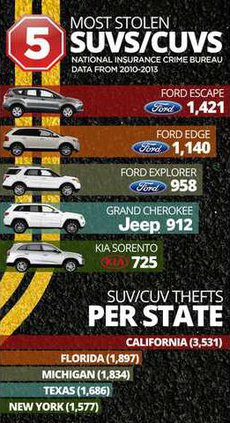Three Ford models topped the list of most stolen SUVs and CUVs, according to a report released Monday.
Investigators from the National Insurance Crime Bureau, a not-for-profit organization, compiled data on stolen 2011 to 2013 model year SUVs and CUVs to determine which makes and models were most targeted by thieves from 2010 to 2013.
“SUVs and CUVs have become a popular choice for consumers over the past decade. As such, they have also become favored by car thieves,” researchers wrote in the report.
The Ford Escape, Ford Edge and Ford Explorer were stolen most often, researchers said. In total there were 1,421 Ford Escapes reported stolen in the three-year span. The Ford Edge was stolen 1,140 times and the Ford Explorer was stolen 912 times.
Nine of the 10 most stolen cars were CUVs. In general, researchers said compact CUVs were stolen the most often, with a total of 6,981 thefts. Large CUVs and mid-sized CUVs were both stolen about 3,200 times.
The state where the most cars were stolen was California, where 3,531 SUVs and CUVs were reported stolen during the three years.
Of the cars that were stolen, 87 percent of them were recovered by March 2014. The Jeep Wrangler and Jeep Cherokee had the largest percentages of vehicles that weren’t recovered, followed by the Cadillac Escalade and Land Rover Range Rover.
“These vehicles may have been targeted by sophisticated organized theft rings which dismantle stolen vehicles or parts, VIN switch them to resell to unsuspecting buyers, or export them to other countries,” researchers wrote.








